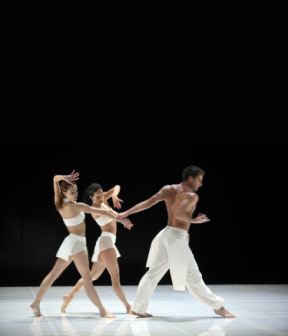When a young choreographer has the bud of a beautiful language but only an intermittent sense of what to do with it, her promise is an open question; as a reviewer I tend to answer in the affirmative, in the hope that the language will win out in the end.
Does it usually? That depends on the powers that be–not just critics, but producers, artistic directors, etc.–recognizing how much it counts for, how much it can lead the way, particularly in such a metaphorically rich, discursively poor art form as dance.
The Hungarian Atilla Kun (no, not Attila the Hun, as I wrote a few times —ayayay! and the movement is so gentle!) is the choreographer in question this time. He brought out the most delicate attentiveness and sincere commitment in the appealing young dancers–most under age 25 and trained locally, at the “national” ballet school of Gyor, a small city (about the size of Berkeley) in northwest Hungary.
Here’s most of my Financial Times review from last week of that company’s, the Gyor National Ballet’s, New York show. (They do ballet in the liberal European sense, not in strict pointe-shoed parlance). They’re touring the program to Western Europe– Switzerland, Austria, and Germany–in March:
Stravinsky is dictatorial enough that a dance not driven by the score risks being left in the dust – the fate of Dimitrij Simkin and James Sutherland’s Petrushka for the Györ National Ballet’s “Stravinsky Evening”, part of New York’s four-month Performing Revolutions festival of Central and Eastern European arts. For the night’s Rite of Spring, however, choreographer Atilla Kun shades the music’s violent upsurge towards a delicate nature without plugging his ears. A feat.
In this 1995 Petrushka , revived for the 20th anniversary of the Soviet Union’s collapse, the curtain rises on a mammoth Red Star. But it is not the shiny undentable icon so much as a skeletal form made of driftwood, each strand worn and individual. The star reflects Simkin’s desire, he writes in the programme, to show that ” ‘big chief’ and small individual were well differentiated” in the Soviet Union of his youth. But he doesn’t differentiate them. Rebellious Petrushka (a gentle Balint Sebestyen), the sinister Magician (a sinuous Balazs Patkai) and the will-less masses perform the same angular, impassive steps even as a panoply of discrete dramas rises up in the magical whir of the music.
Kun, who has been choreographing in his native Hungary for the past decade, hears only certain strains in The Rite of Spring as well: the wend of the bassoon, but not its minor-key menace; the beat’s steadiness, but not its relentlessness. When the promising choreographer describes his Rite as “eleven remarkable artists searching [for] harmony within themselves, as well as through the music of nature and their companions”, you think sleepytime George Winston, not Stravinsky. But the movement’s detail — maintained until the end, when Kun loses his nerve and succumbs to a stock rendition of ritual sacrifice — makes room in the music for gentleness.
Kun is drawn to the body’s rococo tips…

The flamingolike straightness of legs with precise, decorative detail of hands is typical of Kun’s style for Rite. Dancers from our left to right: Virag Sothy, Szabina Cserpak and Balazs Patkai
For the rest of the review, click here.

Leave a Reply